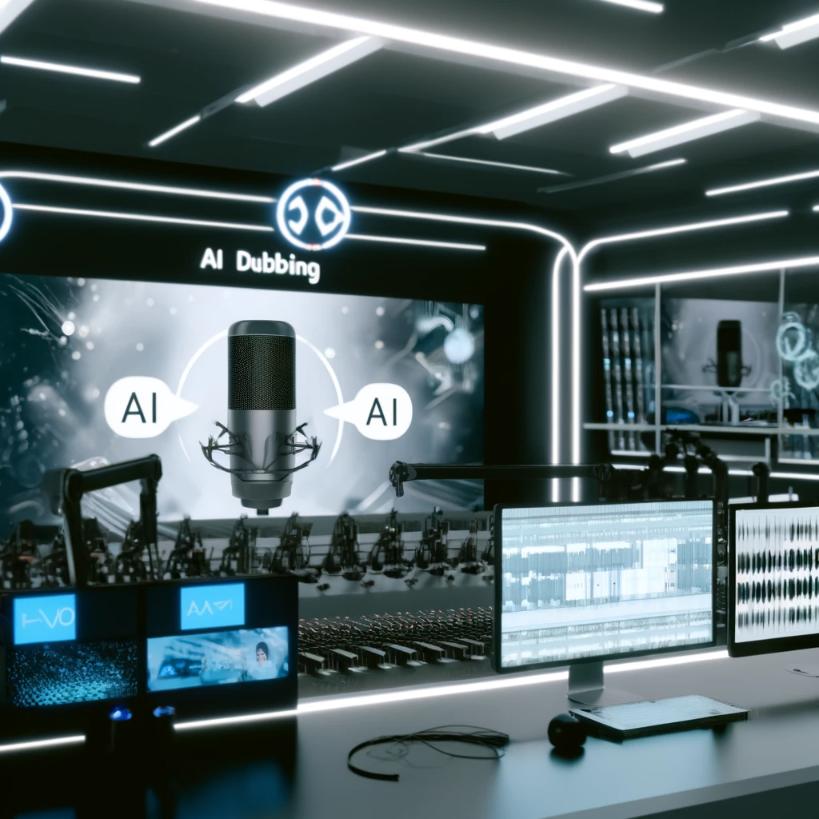Dubbing AI: Exploring AI Dubbing Apps for Enhanced Video Content
Introduction
In today’s digital era, video content dominates the landscape of communication and entertainment, resonating across borders and cultures. However, the challenge of language barriers often limits a video’s reach, confining its impact to audiences who speak the language in which it’s produced. This is where dubbing comes into play, serving as a bridge that connects diverse audiences to the same content. Traditional dubbing, while effective, can be time-consuming and costly, involving multiple actors, directors, and technicians. Enter AI dubbing—a revolutionary approach that leverages artificial intelligence to voice-over videos in multiple languages quickly and efficiently.
AI dubbing utilizes advanced technologies such as speech synthesis and machine learning to generate natural-sounding voiceovers. This not only speeds up the process significantly but also reduces costs, making it accessible for creators ranging from independent YouTubers to large production companies. The importance of dubbing, especially AI-powered, cannot be overstated in its capacity to democratize content consumption. It enables videos to transcend linguistic boundaries, vastly expanding their audience and increasing engagement from viewers worldwide. By adopting AI dubbing, content creators can effortlessly cater to a global audience, ensuring their messages and stories resonate across different cultures and languages, thereby amplifying their reach and impact in the global digital marketplace.
What is AI Dubbing?
AI dubbing is a cutting-edge technology that leverages artificial intelligence to automatically generate voice-overs for video content in multiple languages. This technology utilizes advanced machine learning models and natural language processing to synthesize voices that sound remarkably human-like. The process begins with the AI analyzing the original audio track of a video to understand the tone, pace, and emotional nuances of the speech. It then replicates these aspects in another language, often with the option to customize the voice type and accent to better suit the target audience.
The workflow of AI dubbing significantly streamlines the traditional dubbing process. In conventional methods, dubbing requires a host of professionals, including voice actors, directors, and sound engineers, who must work together to record new audio tracks that sync with the lips and actions of the characters on screen. This can be both time-intensive and expensive, often necessitating multiple takes to achieve perfect alignment and emotional fidelity.
In contrast, AI dubbing automates much of this process. While it might not yet perfectly match the emotional depth provided by skilled human actors, it offers considerable advantages in terms of speed and cost. This makes it especially appealing for projects with tight budgets or timelines, and for content that needs to be accessible in multiple languages swiftly, such as news updates or instructional videos. As AI technology continues to evolve, the gap in emotional expression between human and AI-powered dubbing is narrowing, making it an increasingly viable option for a wide range of multimedia projects.
Best AI Dubbing Apps
 AI dubbing is a powerful tool in the multimedia industry, allowing content creators to expand their reach across linguistic and cultural barriers. Here’s a look at three leading AI dubbing apps: Dubverse, DupDub, and ElevenLabs, each offering unique features tailored to different needs and use cases.
AI dubbing is a powerful tool in the multimedia industry, allowing content creators to expand their reach across linguistic and cultural barriers. Here’s a look at three leading AI dubbing apps: Dubverse, DupDub, and ElevenLabs, each offering unique features tailored to different needs and use cases.
1. Dubverse
- Features and Capabilities: Dubverse provides AI-driven dubbing services that allow for the creation of multilingual voiceovers with natural intonations and emotions. It leverages deep learning models to ensure that voice synthesis matches the original audio in terms of emotion and tone.
- Suitable Use Cases: Ideal for content creators looking to quickly internationalize their video content without the need for extensive recording sessions.
- Target Users: Video bloggers, creators, and digital marketers aiming to increase international viewership by offering content in multiple languages.
2. DupDub
- Features and Capabilities: DupDub specializes in seamless audio and video synchronization, ensuring that dubbed content matches the lip movements and facial expressions of the original videos. This technology enhances the viewing experience by maintaining the naturalness of the video.
- Suitable Use Cases: Particularly useful for film and television producers who need to dub content without compromising the quality of their productions.
- Target Users: Production houses and entertainment companies looking to distribute films and series globally with high-quality dubbing.
3. ElevenLabs
- Features and Capabilities: ElevenLabs stands out with its ability to generate realistic and expressive voice synthesis. It offers a broad range of voices and accents, allowing users to tailor the audio precisely to the target audience’s preferences.
- Suitable Use Cases: Effective for creating educational content, audiobooks, and corporate presentations that require clear and engaging narration in multiple languages.
- Target Users: Educational institutions, audiobook publishers, and businesses needing to communicate complex information across diverse linguistic groups.
Each of these apps provides valuable capabilities that help bridge the gap between content and global audiences, enhancing accessibility and engagement through high-quality AI dubbing. By selecting the appropriate app based on specific project needs, creators can significantly boost the international appeal and effectiveness of their multimedia content.
Pros of Using AI for Dubbing
AI dubbing offers several compelling advantages over traditional dubbing methods, making it an increasingly popular choice among content creators globally. Here are some of the key benefits:
1. Cost-Effectiveness
- Traditional dubbing is a resource-intensive process that requires hiring voice actors, directors, and sound engineers, which can be costly, especially for projects involving multiple languages. AI dubbing, on the other hand, significantly reduces these costs. By utilizing synthetic voices generated through machine learning algorithms, AI dubbing eliminates the need for extensive human resources, making it a more affordable option for both large-scale productions and independent creators. This cost reduction is particularly beneficial for projects with limited budgets or those needing to dub content into several languages.
2. Speed and Efficiency
- AI dubbing accelerates the production timeline. Traditional dubbing requires scheduling sessions with actors, recording multiple takes, and syncing audio to visual elements, which can extend the post-production phase. AI systems can generate dubbed audio in a fraction of the time, often with the ability to process minutes or even hours of content in just moments. This speed enables faster turnaround times for projects, allowing creators to meet tight deadlines and rapidly update content if necessary.
3. Consistency and Error Reduction
- Maintaining consistency across multiple languages can be challenging in traditional dubbing, as different actors bring their interpretations to their performances, which can vary from the original content in tone and intent. AI dubbing, however, can preserve the nuances of the original performance, ensuring consistency across all languages. Additionally, AI algorithms can minimize human errors such as mispronunciations or timing issues, providing a higher overall quality and uniformity in the final product. This consistency is crucial for maintaining the integrity of content as it reaches diverse global audiences.
Overall, AI dubbing transforms how content is produced and shared across different linguistic and cultural landscapes. By leveraging AI, creators can enjoy reduced costs, enhanced production speeds, and improved consistency and accuracy in their multilingual content, making it an essential tool for anyone looking to expand their global reach.
Cons of Using AI for Dubbing
While AI dubbing offers significant advantages, there are also some notable limitations and challenges associated with its use. These drawbacks can impact the overall effectiveness and reception of dubbed content.
1. Limitations in Emotional Range and Nuances
- One of the primary challenges of AI dubbing is its current inability to fully replicate the emotional depth and subtleties that human actors bring to performances. AI-generated voices can sometimes sound flat or monotonous, lacking the nuanced expressions and emotional variations that are crucial for engaging storytelling. This can make the content feel less relatable or compelling, particularly in genres heavily reliant on emotional engagement such as drama or romance.
2. Challenges with Cultural and Linguistic Accuracy
- Cultural and linguistic accuracy is critical in dubbing. AI systems, despite their advancements, often struggle with context-specific idioms, cultural references, and regional dialects. This can lead to translations or dubbing that feels unnatural or insensitive to native speakers, potentially alienating the audience. Ensuring cultural and linguistic appropriateness requires not just advanced AI but also input from native speakers and cultural consultants, which can complicate the dubbing process.
3. Dependence on the Quality of the AI Model and Training Data
- The effectiveness of AI dubbing heavily depends on the quality of the underlying AI models and the training data used to develop them. If the training data is limited or biased, the AI’s output can be flawed. This dependence means that continuous updates and improvements are necessary to enhance the AI’s performance, which can be a significant ongoing investment for companies relying on this technology. Additionally, issues like mispronunciations, awkward phrasing, and syncing errors can occur if the AI model isn’t sufficiently robust or well-tuned.
Despite these challenges, AI dubbing continues to evolve rapidly, with improvements in machine learning and natural language processing helping to mitigate many of these issues. However, content creators must weigh these cons against the pros when deciding whether to use AI dubbing for their projects. As technology advances, it is likely that many of the current limitations will be addressed, making AI dubbing an even more valuable tool in the global content distribution toolkit.
Why Implement a Dubbing Strategy?
 Dubbing is not merely a translation of words from one language to another; it’s an essential strategy for content creators aiming to make their work universally accessible and engaging. Implementing a dubbing strategy can transform the reach and impact of video content in several crucial ways.
Dubbing is not merely a translation of words from one language to another; it’s an essential strategy for content creators aiming to make their work universally accessible and engaging. Implementing a dubbing strategy can transform the reach and impact of video content in several crucial ways.
1. Enhancing Viewer Engagement Across Different Language Speakers
- The primary goal of dubbing is to make content resonate with viewers in their native language, thereby enhancing engagement. When audiences watch content in their own language, they are more likely to connect emotionally and culturally, which significantly boosts viewer satisfaction and retention. Dubbing ensures that the humor, drama, and subtleties of content are effectively communicated, overcoming the barrier that subtitles or language gaps may pose.
2. Expanding the Reach of Video Content Globally
- By implementing a dubbing strategy, content creators can tap into new markets and demographics that were previously unreachable due to language barriers. This global reach is not just beneficial for viewer numbers but also opens up opportunities for monetization and partnerships with international brands and platforms. Dubbing makes content accessible to a worldwide audience, increasing its potential viral spread and cultural impact.
3. Increasing Accessibility for Non-Native Speakers
- Accessibility is a critical aspect of content creation, particularly in our increasingly globalized world. Dubbing ensures that non-native speakers and those with hearing impairments who might struggle with subtitles can enjoy video content without barriers. This inclusivity is not only a moral imperative but also broadens the audience base, making the content more popular and successful.
A well-implemented dubbing strategy can significantly enhance the overall value and effectiveness of video content. It caters to a broader audience, fosters deeper connections with viewers, and promotes inclusivity. As digital content continues to dominate the media landscape, the ability to engage with audiences across cultural and linguistic divides will be increasingly crucial for success.
Conclusion
Integrating AI dubbing into video content strategies presents a transformative opportunity for content creators and broadcasters across the globe. This technology enables the production of multilingual content with unprecedented speed and efficiency, breaking down linguistic barriers and opening up new avenues for global reach and audience engagement.
AI dubbing not only makes content accessible to a wider audience but also enhances the viewer experience by providing them with content in their native language, which is more relatable and engaging. This can lead to increased viewer retention, broader brand exposure, and potentially higher monetization opportunities for creators. Furthermore, the cost-effectiveness of AI dubbing allows even smaller content producers to compete on a global stage, democratizing content creation and distribution.
However, it’s important to approach AI dubbing with an awareness of its current limitations, particularly regarding emotional expressiveness and cultural nuances. The best strategy may involve a hybrid approach, combining AI with human oversight to ensure that the final product respects cultural sensitivities and maintains emotional depth.
As AI technology continues to advance, we can anticipate improvements that will address these challenges more effectively. For now, content creators should consider AI dubbing as a valuable tool in their arsenal, one that can significantly enhance their content strategy and help them make an impact on a global scale. By staying informed about technological advancements and continuously evaluating their content strategies, creators can leverage AI dubbing to its fullest potential, ensuring that their content is not only heard but also felt by audiences worldwide.

